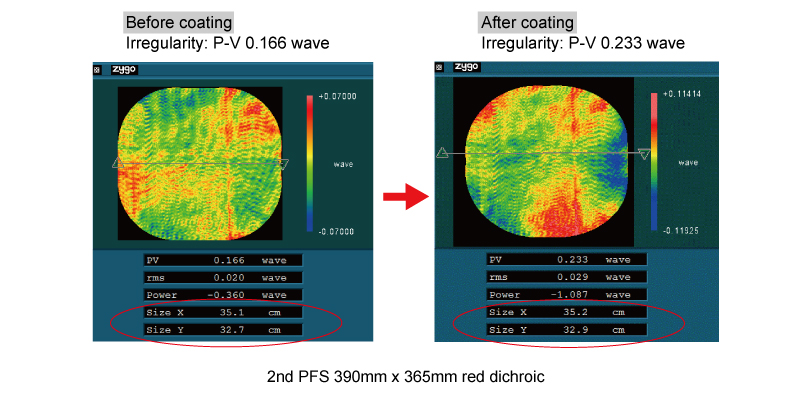Dichroic beam splitters
Dichroic beam splitter is now getting more important for the state-of-the-art spectrograph such as Dark Energy Spectroscopic
Instrument (DESI), Prime Focus Spectrograph (PFS), 4MOST, MOONS, or for multi-channel CCD cameras to take images
in different colours simultaneously.
Dichroic beam splitter splits the incident beam to two directions, eventually gives an influence to the performance of at least
two or more cameras in terms of wavefront error, throughput, or available wavelength range.
Essential requirements for astronomical dichroic beam splitter are as follows.
a) High reflection in (often broad) band
b) High transmission in (often broad) band
c) Sharp transition from reflection to transmission
d) Minimized reflected wavefront error *after coating*
e) Minimized transmitted wavefront error *after coating*
Both a) and b) contribute the high overall throughput of the instrument.
c) contributes to minimize unavailable wavelength range.
The key technique is to reduce the separation of p and s-polarization at the specified incident angle.
Both d) and e) contribute the image quality of the instrument.
There are few vendors in the world that can achieve all the requirements.
Asahi is one of potential vendors to provide such dichroic beam splitters.
We provided PFS 390mm x 365mm red dichroic beam splitter, total 4 pcs.
All the dichroics were perfectly compliant with the hard specifications requested by the PFS team.


CaF2 based IR dichroic beam splitter
Silicon, sapphire, or CaF2 is usually used as a substrate for IR optics.
However, regarding silicon, the wavelengths from optical region to Y band are not available due to the absorption.
Sapphire is a good material in terms of transmission from optical to IR region, but too solid to polish the surface precisely.
This is disadvantageous to make good surface flatness, which must be essential for dichroic beam splitters.
CaF2 is also good in terms of transmission, but difficult to be handled.
Because it is fragile and very sensitive against thermal shock.
Asahi succeeded in making CaF2 based and wedged 100mm dichroic and provided it to the instrument at Keck in Hawaii.

